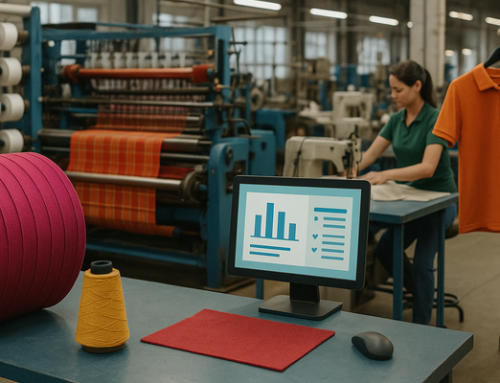New Textile Revolution: Smart Textiles and Wearable Electronics
“Oh my God, you look so smart today!”
Be careful, a compliment like this doesn’t necessarily mean you’re looking stylish and elegant. Surrounded by all kinds of gadget, from smart phones and smart watches, to smart cars and buildings, nowadays looking smart means much more.
An astounding prediction suggests that by 2025, about 10% of all electronics will be worn as part of our clothing. This isn’t just a number; it marks the beginning of a big change in how we think about clothes and technology. Imagine a world where your shirt or jacket does more than just keep you warm or stylish – it becomes a smart device, seamlessly blending technology with fabric.
We’re moving beyond clothes that only cover our bodies to ones that connect with us, offer protection, and adjust to our needs. This shift isn’t just a passing trend; it’s a revolution that’s redefining the very concept of clothing itself.
What are Smart Textiles?
Smart textiles, also known as e-textiles or intelligent textiles, represent a unique category of advanced materials that seamlessly integrate electronic components, sensors, and interactive capabilities directly into the fabric structure. These innovative textiles are designed to go beyond the traditional passive properties of conventional fabrics, enabling them to sense, react, and interact with the user and their surroundings.
The definition of smart textiles encompasses a wide range of materials that exhibit characteristics of smart fabrics, such as the ability to sense environmental changes, adapt to various conditions, and provide interactive functionality. These textiles are created by carefully incorporating electronic elements, including embedded electronics in textiles and textile-integrated sensors, within the fabric structure.
Types of Smart Fabrics and Materials Used
These advanced textiles can be broadly categorized into two main types: active smart fabrics and passive smart fabrics.
Active smart fabrics are characterized by their ability to sense changes in their environment and respond accordingly. These textiles often incorporate materials such as shape memory alloys, electroactive polymers, and thermochromic dyes, which allow them to change their color, shape, or stiffness based on various stimuli. This responsiveness makes active smart fabrics ideal for applications in adaptive clothing, thermal regulation, and interactive user experiences.
In contrast, passive smart fabrics focus more on monitoring and gathering data from the user or their surroundings, without actively changing their properties. These textiles may incorporate conductive materials, responsive textile materials, and nanomaterials to enable functions such as UV protection, air quality sensing, and environmental monitoring.
While they may not exhibit the same level of dynamic responsiveness as active smart fabrics, passive smart textiles play a crucial role in providing valuable data and insights for various applications, from healthcare to military and workplace safety.
Beyond these broad categories, smart textiles can also be classified based on the specific textile composites and advanced materials used in their construction. Researchers and manufacturers are continuously exploring innovative ways to integrate cutting-edge technologies, such as conductive materials and nanomaterials, into textile structures to enhance the capabilities and versatility of smart fabrics.
Integration of Sensors in Weaves and Fibers
The ultimate goal of smart fabrics technology is the seamless integration of electronics in fabrics, encapsulating a holistic approach to wearable electronics. This integration enables the creation of textiles that not only provide traditional comfort and style, but also extend sophisticated functionalities like health monitoring, change in color or pattern in response to environmental stimuli, and connectivity with smartphones or other devices.
This process involves integrating conductive threads, sensors, and electronics within the fibers and weaves of textiles, enabling them to respond to environmental changes or user inputs and to perform specific functions beyond their conventional capabilities.
Sensors are integrated into smart textiles by weaving or embroidering them into the fabric, or by applying them to the surface of the fabrics using methods like printing. These sensors can be designed to monitor environmental conditions like temperature and humidity or to track physiological data such as heart rate and muscle activity.
Applications and Benefits of E-Textiles in Wearable Electronics
Smart textiles have a wide range of applications in the field of wearable electronics, revolutionizing the way we interact with our clothing and accessories. One of the most prominent applications is in the healthcare and fitness sectors, where smart textiles in wearable technology are used for continuous health and activity monitoring.
Health and Fitness Monitoring
The integration of healthcare applications of smart fabrics into wearable devices allows for the seamless tracking of vital signs, physical activity, and overall wellness. From heart rate and respiratory patterns to body temperature and sleep quality, smart textiles can provide healthcare professionals and fitness enthusiasts with a comprehensive view of an individual’s health status, enabling early detection of potential issues and personalized guidance for improved well-being.
Interactive and Responsive Clothing
Beyond healthcare and fitness applications, smart textiles are also revolutionizing the world of interactive clothing and fashion. These advanced materials incorporate sensors, actuators, and responsive capabilities that allow garments to adapt to the wearer’s needs and preferences. From adaptive and responsive textile applications that adjust temperature and moisture levels, to clothing that provides haptic feedback or visual effects, smart textiles are redefining the boundaries between technology and style, offering a new era of fitness and sports applications for active individuals.
The integration of smart textiles in wearable electronics is paving the way for a future where our clothing and accessories seamlessly blend form, function, and interactivity, enhancing our daily lives and improving our overall well-being.
Monitoring and Sensing Capabilities for Health and Wellness
Smart textiles are revolutionizing the way we monitor and manage our health and wellness. By integrating a variety of sensors directly into the fabric structure, these advanced materials can track vital signs and physiological data with unprecedented accuracy and convenience.
Vital Signs Tracking
Smart textiles equipped with textile-based sensors are capable of continuously monitoring an individual’s vital signs, including heart rate, respiration rate, blood pressure, and body temperature. This real-time data can provide valuable insights into the wearer’s overall health and well-being, enabling early detection of potential medical issues and allowing for personalized wellness monitoring.
Posture and Movement Monitoring
Beyond vital signs tracking, smart textiles can also analyze the wearer’s posture and movement patterns. By integrating sensors that detect changes in pressure, strain and body positioning, these advanced fabrics can provide detailed information about the user’s activity levels, sleep quality, and even potential issues related to musculoskeletal health. This data can be used to promote better posture, improve physical rehabilitation, and encourage healthier lifestyle choices.
Challenges and Innovations in Smart Textile Technology
One of the major challenges in the development of smart textiles is large-scale manufacturing, as creating a prototype can be time-consuming. However, with the growing interest in smart textiles, solutions today are being developed to address these challenges. By incorporating conductivity and led lights into garments, smart textiles can offer functionality that extends beyond what a smartwatch can provide. These stylish and high-tech fabrics are finding applications in many fields, from aerospace to enhancing our daily lives.
Exploring Sustainable Practices in Smart Textile Manufacturing
The development of sustainable smart textiles reflects a growing commitment to eco-friendly practices within fabric manufacturing. Leaders in textile innovation are exploring ways to reduce carbon footprints and waste, using biodegradable materials and recycling electronic elements. These efforts not only respond to global environmental concerns but also tap into consumer desire for greener wearable technology.
As we look ahead to the future of wearable electronics, we envision a world where smart fabrics seamlessly blend into our everyday lives, making everything from our clothes to our car seats and home furnishings smarter and more intuitive.
Picture jackets that adjust to the weather, shirts that track our health, and linens that make our homes more comfortable. They’re not just a trend—they’re becoming essential parts of our lives, shaping the way we live in the years to come.
Discover smart apparel ERP software solution for smart textiles.




